How to Make Yoga a Fun Activity for Your Pet

Tips for Making Yoga a Fun Activity for Your Pet:
- Incorporate interactive elements and props
- Tailor poses to their abilities
- Enjoy the boundless joy of pet-friendly yoga.
Key Takeaways
- Incorporate interactive elements and props to make yoga more engaging for your pet.
- Consider your pet's individual needs and abilities when choosing the right yoga poses.
- Create a safe and comfortable space for your pet's yoga practice with calming ambiance and proper lighting.
- Introduce your pet to yoga props and adapt them creatively to suit their size and preferences.
Choosing the Right Yoga Poses
When choosing the right yoga poses for your pet, it's important to consider their individual needs and abilities. Just like humans, pets have different bodies and physical limitations, so it's essential to modify poses accordingly. Modifying poses can help your pet experience the benefits of yoga without straining or injuring themselves.
One of the main benefits of yoga for pets is improved flexibility. Dogs, for example, can greatly benefit from poses that stretch their muscles and joints. Downward Dog is a popular pose that can help stretch the spine and legs of your furry friend. Cats, on the other hand, are naturally flexible creatures, so poses like Cat-Cow can be great for them.
Another benefit of yoga for pets is increased relaxation and reduced anxiety. Poses that promote relaxation, such as Child's Pose, can help calm your furry friend's nervous system and provide a sense of security. This pose can be especially beneficial for pets who suffer from separation anxiety or who are easily stressed.
Preparing a Safe and Comfortable Space
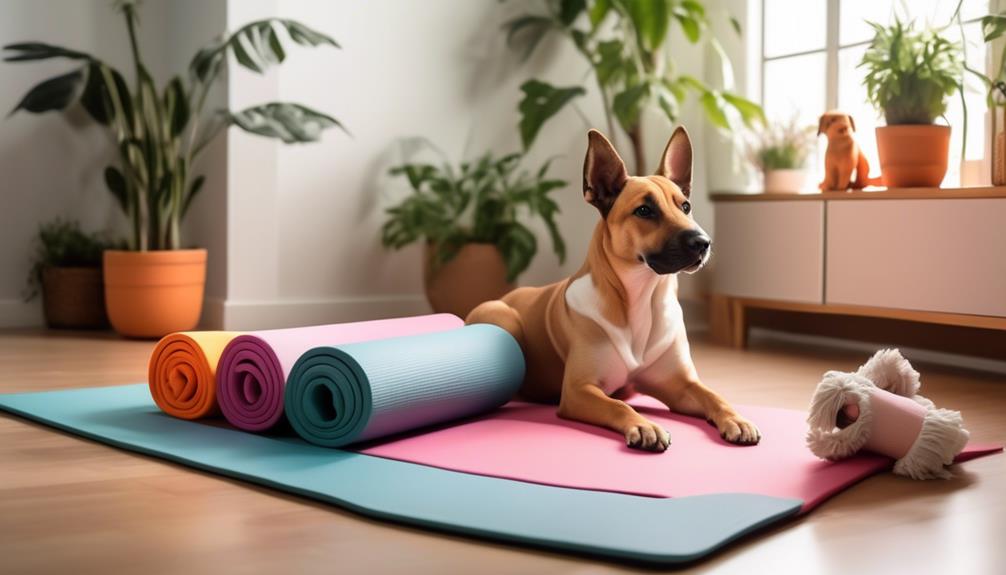
To ensure the safety and comfort of your pet during a yoga session, it is important to create a secure and cozy space for them. Creating a calming ambiance and setting up proper lighting can go a long way in making your pet feel at ease.
When preparing a safe and comfortable space for your pet, consider the following tips:
| Creating a calming ambiance | Setting up proper lighting |
|---|---|
| Use soft, soothing colors | Provide natural light |
| Play soft, relaxing music | Avoid harsh, bright lights |
| Dim the lights | Use candles or lamps |
| Add comfortable bedding | Avoid flickering lights |
Creating a calming ambiance involves using soft, soothing colors that promote relaxation. You can also play soft, relaxing music to set the mood. Additionally, dimming the lights can create a cozy and tranquil environment.
Proper lighting is essential for both you and your pet during a yoga session. It is best to provide natural light if possible. If natural light is not available, use candles or lamps to create a warm and inviting atmosphere. Avoid harsh, bright lights and flickering lights, as they can be distracting and unsettling for your pet.
Introducing Your Pet to Yoga Props
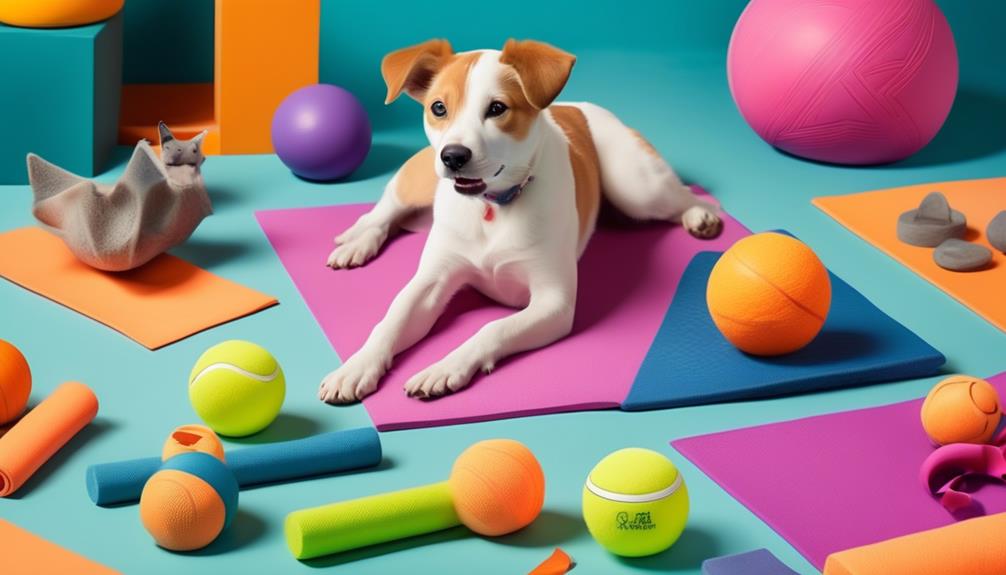
Now that your pet is comfortable in their yoga space, it's time to introduce them to yoga props.
Choosing the right props is essential to ensure your pet's safety and enjoyment.
Choosing the Right Props
Introduce your furry friend to the wonderful world of yoga props, ensuring their comfort and enjoyment. When choosing the right props for your pet, consider their size, preferences, and needs. Here are some options to explore:
- Yoga prop alternatives: If your pet isn't comfortable with traditional yoga props, you can try using alternatives like soft cushions or blankets to provide support and comfort during poses.
- Incorporating toys: Incorporating your pet's favorite toys can make the yoga session more engaging. You can use toys as distractions or incentives to encourage their participation.
- Pet-specific props: Some companies offer pet-specific yoga props like pet-sized yoga mats or interactive toys designed for stretching and movement.
- Adapting human props: With some creativity, you can adapt human yoga props to suit your pet's needs. For example, using a small foam block or a rolled-up towel as a prop for your pet.
Safety Precautions for Pets
When introducing your pet to yoga props, it's important to prioritize their safety and well-being.
While pet yoga can provide many benefits, such as improved flexibility and relaxation, it's essential to take precautions to prevent any potential injuries.
One common pet yoga injury is strained muscles or joints, especially if the pet isn't properly warmed up before engaging in poses. Therefore, it's recommended to start with gentle stretches and gradually increase the intensity.
Additionally, it's crucial to choose props that are suitable for your pet's size and strength, ensuring they can handle the weight and pressure.
Always supervise your pet during their yoga practice and be attentive to any signs of discomfort or distress.
Incorporating Props Into Poses
After ensuring your pet's safety during their yoga practice, you can now explore the exciting world of incorporating props into poses, introducing them to a whole new level of fun and engagement. Props can enhance your pet's yoga experience by providing them with additional support and stimulation. Here are some ideas to get you started:
- Using Treats: Incorporate treats into certain poses to encourage your pet's participation and reward their efforts. For example, you can place a treat on their paw during a balancing pose, motivating them to stay focused and engaged.
- Engaging Toys: Introduce interactive toys that can be incorporated into yoga poses. For instance, you can use a toy ball during stretches or a tug-of-war toy for a playful twist on partner poses.
- Blankets and Mats: Provide extra comfort and cushioning for your pet by using blankets or mats during their yoga practice. This can help them relax and feel more at ease while trying out different poses.
- Tunnels and Hoops: Create a playful obstacle course using tunnels and hoops to encourage your pet's agility and flexibility. They can crawl through tunnels or jump through hoops, making their yoga practice more dynamic and enjoyable.
Remember to choose props that are safe and suitable for your pet's size and breed. By incorporating props into your pet's yoga practice, you can make it a truly enriching and entertaining experience for them.
Incorporating Playful Interactions During Yoga
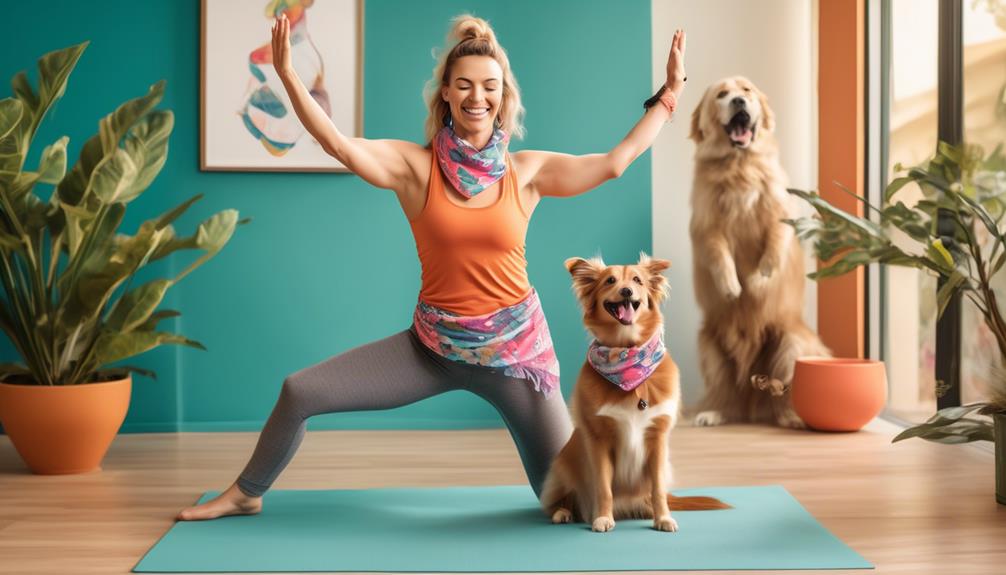
Looking to make your yoga practice more enjoyable for your furry friend? Incorporating playful interactions during yoga can't only make it a fun activity for your pet but also enhance the bonding experience between you and your beloved companion. Pet yoga, also known as doga, has numerous benefits, including mental stimulation and physical exercise for your pet. It can help them release pent-up energy, reduce anxiety, and promote relaxation.
To engage your pet during yoga sessions, you can try some creative ways that will keep them entertained. One idea is to incorporate their favorite toys into your practice. You can encourage them to play with their toys while you perform yoga poses nearby. This way, they can have fun and be part of the activity.
Another option is to include interactive movements that involve your pet. For example, you can incorporate gentle stretches where you reach out and touch your pet's paws or gently massage their back. This not only allows for physical contact but also helps calm and relax your pet.
Additionally, you can try incorporating playful poses that involve your pet. For instance, you can go into a modified downward-facing dog pose while encouraging your pet to crawl underneath you. This playful interaction can be a source of joy for both of you.
Remember to always prioritize your pet's safety and comfort during these playful interactions. Pay attention to their body language and adjust accordingly. By incorporating these creative and playful interactions, you can make your yoga practice a fun and enjoyable experience for your pet while deepening your bond together.
Tailoring Yoga Poses to Your Pet's Abilities
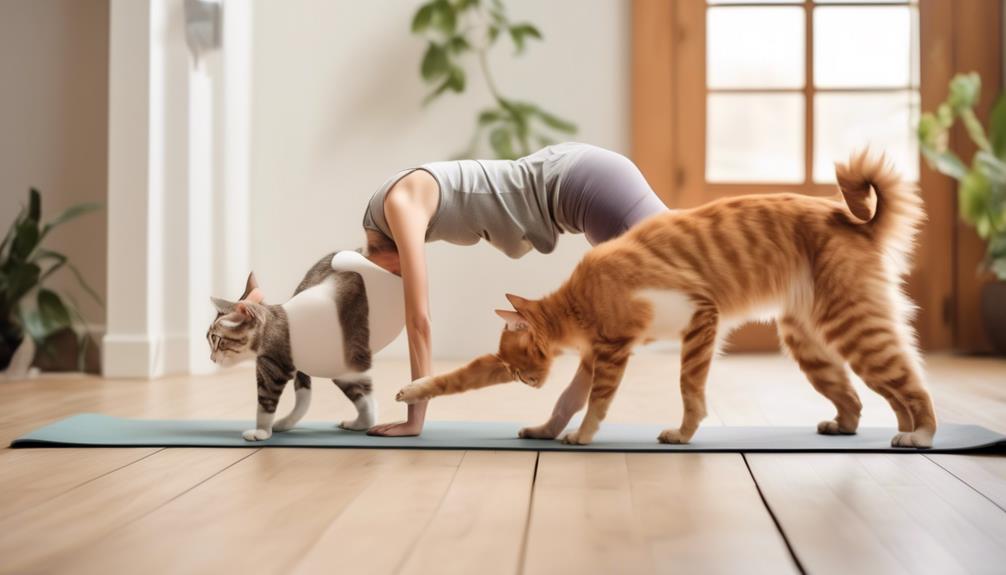
To ensure a safe and effective yoga practice for your pet, it's important to tailor yoga poses to their individual abilities and limitations. Just like humans, pets have different levels of flexibility, strength, and balance. Adapting poses and modifying techniques will help your furry friend participate in yoga in a way that's comfortable and beneficial for them.
Here are some tips to help you tailor yoga poses to your pet's abilities:
- Start with simple poses: Begin with basic poses that are easy for your pet to understand and perform. This will build their confidence and allow them to gradually progress to more challenging poses.
- Use props for support: Props such as blankets or pillows can provide additional support and stability for your pet during yoga poses. They can help modify poses to suit their comfort level.
- Focus on gentle stretches: Choose poses that gently stretch your pet's muscles without putting too much strain on their joints. This will help improve their flexibility and range of motion.
- Listen to your pet's cues: Pay attention to your pet's body language and reactions during yoga. If they seem uncomfortable or in pain, modify or skip the pose altogether. Always prioritize their well-being.
Including Breathing Exercises for Relaxation
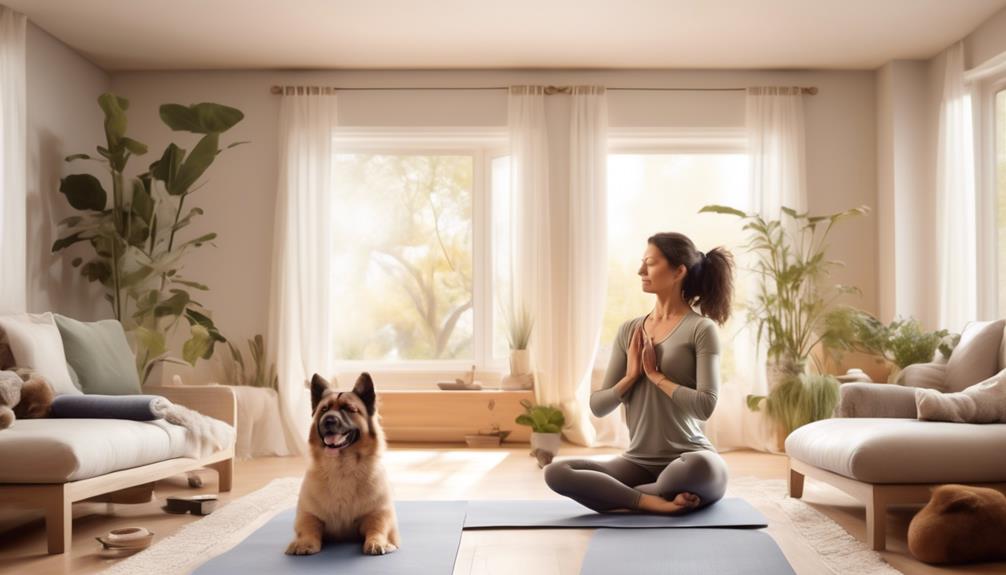
Including breathing exercises in your pet's yoga practice can promote relaxation and enhance their overall well-being. Just like humans, animals can benefit from breathing techniques for stress reduction. Deep breathing exercises can help calm their nervous system, reduce anxiety, and improve mental clarity.
When practicing yoga with your pet, take a few moments to focus on their breathing. Encourage them to take slow, deep breaths in and out. You can gently place a hand on their chest or belly to feel their breath and provide a soothing touch. As they inhale, imagine them filling their lungs with fresh air, and as they exhale, visualize them releasing any tension or stress.
This simple practice can have a profound impact on your pet's mental health. It can help them feel more centered, relaxed, and connected to the present moment. Remember to be patient and gentle as you introduce breathing exercises to your pet's yoga routine. With time and practice, you'll notice the positive effects it has on their overall well-being.
Ending the Session With a Relaxing Pet Massage

After a rewarding session of yoga with your pet, treat them to a soothing and relaxing massage to help them unwind and fully embrace the benefits of their practice. Just like humans, pets can benefit greatly from a massage, both physically and emotionally.
Here are some pet massage benefits and different pet massage techniques to help you create a calming experience for your furry friend:
- Reduced Stress: Massages can help reduce stress and anxiety in pets, promoting a sense of calm and relaxation.
- Improved Circulation: Gentle massage techniques can improve blood flow and circulation, promoting overall health and well-being.
- Enhanced Flexibility: Massaging your pet's muscles can help improve their flexibility, making movement easier and more comfortable for them.
- Bonding Experience: A massage isn't only beneficial for your pet, but it can also deepen the bond between you and your furry companion, creating a sense of trust and connection.
When giving your pet a massage, it's important to use gentle and slow strokes, avoiding any sensitive areas or applying too much pressure. You can use your hands, fingertips, or even a soft brush to massage your pet. Take your time and observe their reactions to ensure they're enjoying the experience.
Frequently Asked Questions
Can I Use My Own Yoga Mat for My Pet to Practice On?
Yes, you can definitely use your own yoga mat for your pet to practice on. However, it's recommended to use a pet-friendly yoga mat to ensure their comfort and safety during the yoga poses for pets.
What Types of Yoga Props Are Safe for Pets to Use?
There are several types of yoga props that can be safe for pets to use, such as pet-friendly yoga mats, toys, and blankets. Incorporating these props into your pet's yoga practice can enhance their flexibility and mental well-being.
How Long Should a Yoga Session Be for My Pet?
A yoga session for your pet should be about 15-30 minutes long, depending on their fitness level and attention span. Regular yoga practice can improve their flexibility, reduce anxiety, and strengthen the bond between you.
Can I Practice Yoga With Multiple Pets at the Same Time?
Practicing yoga with multiple pets can be a fun and beneficial experience. It allows for a deeper bond with your furry friends and promotes physical and mental well-being for both you and your pets.
Are There Any Specific Yoga Poses That Can Help With My Pet's Specific Health Condition?
There are several yoga poses that can help with a pet's specific health condition. For example, downward dog can strengthen their back and hips, while cat-cow can improve flexibility and digestion. Regular yoga practice with your pet can have numerous benefits.









